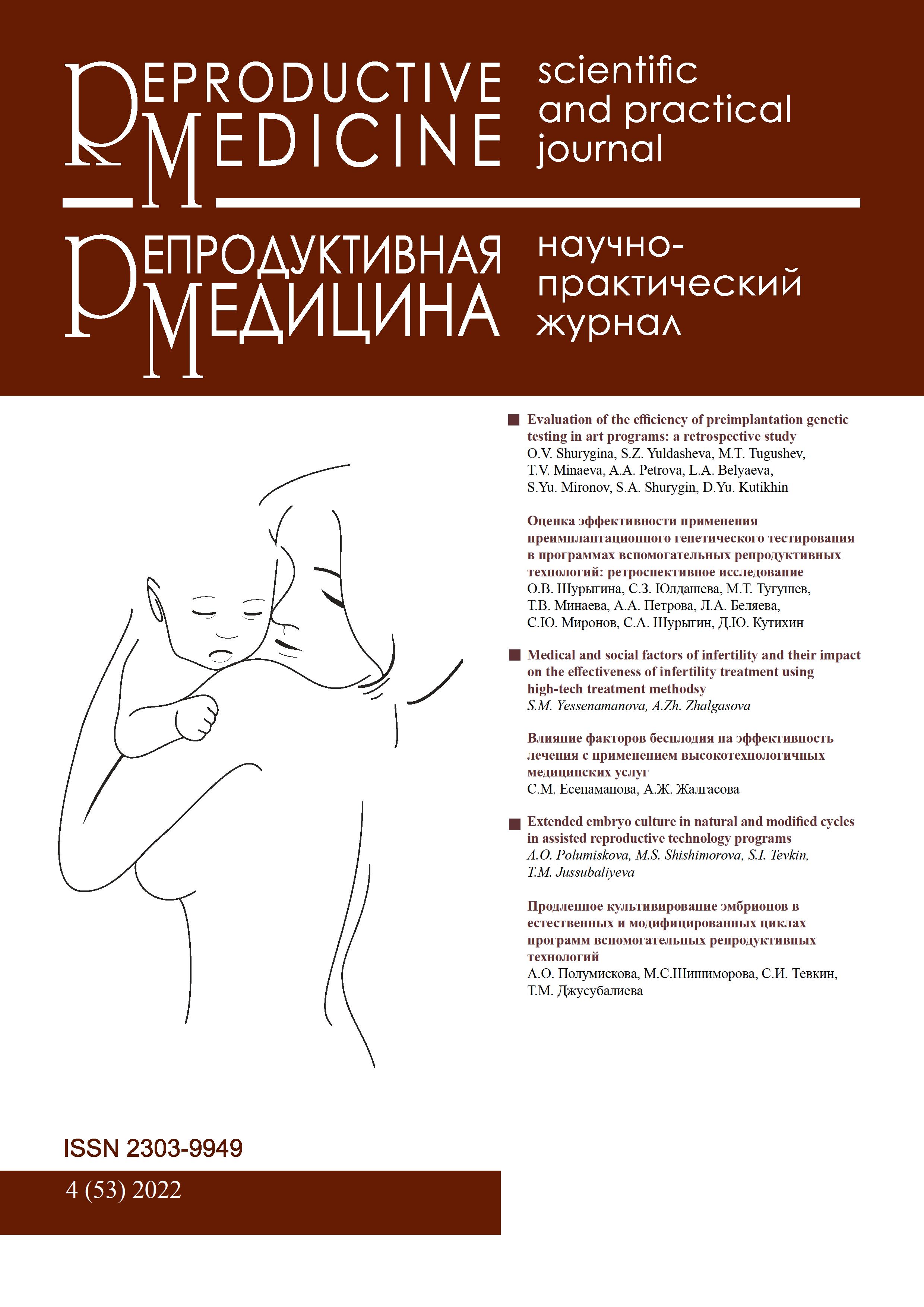Pregnancy and childbirth in patients after correction of the position of pronuclei in oocytes using a calcium ionophore
DOI:
https://doi.org/10.37800/RM.3.2022.87-92Keywords:
ICSI, calcium ionophore, pronuclei, assisted oocyte activation, pregnancyAbstract
Relevance: Continuous improvement of assisted reproductive technologies (ART) helps treat most types of infertility. Currently, intracytoplasmic sperm injection (ICSI) is widely used in reproductive medicine in cases of severe male or idiopathic infertility, which allows for obtaining fertilized oocytes. But even zygotes with two pronuclei cannot always develop correctly and reach the blastocyst stage. An important criterion for forming a normal blastocyst is the central location of the pronuclei in the zygote. The search for methods that increase the effectiveness of ART programs is one of the most current issues in reproductive medicine.
The study aimed to report pregnancy and childbirth after the transfer of oocyte-derived blastocysts due to the pronuclear position correction using calcium ionophores in ICSI programs.
Methods: Our study describes five clinical cases of calcium ionophore use after unsuccessful ICSI programs. In all cases, the non-central position of the pronuclei was noted in previous programs. After intracytoplasmic injection, a calcium ionophore was used to correct the pronuclei position in fertilized oocytes.
Results: Embryos were transferred into the uterine cavity on Day 5. The onset of clinical pregnancy was noted in 80% of cases. After using calcium ionophore, 83% of oocytes that received intracytoplasmic sperm injection were normally fertilized and had a central position of pronuclei. Also, 40% of good to excellent-quality blastocysts were obtained. In 4 patients, a singleton pregnancy was observed, and at the moment, all pregnancies ended in childbirth. The outcome of the fifth patient’s program remained unknown.
Conclusion: Activation of oocytes with a calcium ionophore after ICSI can be used to correct the position of pronuclei, which can affect the efficiency of blastocyst implantation and, accordingly, the successful outcome of the ART program.
References
Swann K. The role of Ca2+ in oocyte activation during In Vitro fertilization: Insights into potential therapies for rescuing failed fertilization // Biochim. Biophys. Acta BBA - Mol. Cell Res. 2018. Vol. 1865, № 11, Part B. P. 1830–1837.
Zafar M.I., Lu S., Li H. Sperm-oocyte interplay: an overview of spermatozoon’s role in oocyte activation and current perspectives in diagnosis and fertility treatment // Cell Biosci. 2021. Vol. 11, № 1. P.
Kashir J. et al. Oocyte activation deficiency and assisted oocyte activation: mechanisms, obstacles and prospects for clinical application // Hum. Reprod. Open. 2022. Vol. 2022, № 2. P. hoac003.
Chansel-Debordeaux L. et al. Reproductive outcome in globozoospermic men: update and prospects // Andrology. 2015. Vol. 3, № 6. P. 1022–1034.
Eftekhar M. et al. Effect of oocyte activation with calcium ionophore on ICSI outcomes in teratospermia: A randomized clinical trial // Iran. J. Reprod. Med. 2013. Vol. 11, № 11. P. 875–882.
Sanusi R. et al. Rescue of failed oocyte activation after ICSI in a mouse model of male factor infertility by recombinant phospholipase C // Mol. Hum. Reprod. 2015. Vol. 21, № 10. P. 783–791.
Tavalaee M., Nasr-Esfahani M.H. Expression profile of PLC, PAWP, and TR-KIT in association with fertilization potential, embryo development, and pregnancy outcomes in globozoospermic candidates for intra-cytoplasmic sperm injection and artificial oocyte activation // Andrology. 2016. Vol. 4, № 5. P. 850–856.
Janghorban-Laricheh E. et al. An association between sperm PLC levels and varicocele? // J. Assist. Reprod. Genet. 2016. Vol. 33, № 12. P. 1649–1655.
Anifandis G. et al. Artificial oocyte activation: physiological, pathophysiological and ethical aspects // Syst. Biol. Reprod. Med. 2019. Vol. 65, № 1. P. 3–11.
Miller N. et al. Oocyte activation by calcium ionophore and congenital birth defects: a retrospective cohort study // Fertil. Steril. 2016. Vol. 106, № 3. P. 590-596.e2.
Jones C., Meng X., Coward K. Sperm factors and egg activation: Phospholipase C zeta (PLCZ1) and the clinical diagnosis of oocyte activation deficiency // Reprod. Camb. Engl. 2022. Vol. 164, № 1. P. F53–F66.
Santos M. et al. Revised guidelines for good practice in IVF laboratories (2015) // Hum. Reprod. 2016. Vol. 31.
Shan Y. et al. Assisted Oocyte Activation With Calcium Ionophore Improves Pregnancy Outcomes and Offspring Safety in Infertile Patients: A Systematic Review and Meta-Analysis // Front. Physiol. 2022. Vol. 12. P. 751905.
Darwish E., Magdi Y. A preliminary report of successful cleavage after calcium ionophore activation at ICSI in cases with previous arrest at the pronuclear stage // Reprod. Biomed. Online. 2015. Vol. 31, № 6. P. 799–804.
Isachenko E. et al. Pregnancy after the calcium ionophore correction of pronuclei position in oocytes after intracytoplasmic sperm injection // Fertil. Steril. 2010. Vol. 94, № 7. P. 2770.e3-5.
Caglar Aytac P. et al. Can calcium ionophore “use” in patients with diminished ovarian reserve increase fertilization and pregnancy rates? A randomized, controlled study // Fertil. Steril. 2015. Vol. 104, № 5. P. 1168–1174.
Downloads
Published
How to Cite
Issue
Section
License
The articles published in this Journal are licensed under the CC BY-NC-ND 4.0 (Creative Commons Attribution – Non-Commercial – No Derivatives 4.0 International) license, which provides for their non-commercial use only. Under this license, users have the right to copy and distribute the material in copyright but are not permitted to modify or use it for commercial purposes. Full details on the licensing are available at https://creativecommons.org/licenses/by-nc-nd/4.0/.




